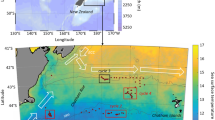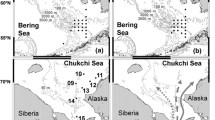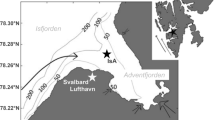Abstract
Planktonic larvae of the amphioxus Branchiostoma belcheri were collected in the western part of the Seto Inland Sea, Japan, in order to document their seasonal occurrence, recruitment, and growth patterns. The larvae appeared from mid-July to early October and their size ranged from 0.6 to 5.5 mm. Three distinct cohorts were observed during the summers, indicating multiple, synchronous spawning within the population. The length increment pattern of a cohort demonstrates slow growth for at least a week during the early larval stage. July 10, 20, and 30 are the inferred dates when spawnings started to produce the three cohorts in 2001. Favorable temperature range for spawning was 21–23°C. Bias in population structure due to advection can be assumed to be negligible; therefore the length increment of the cohort, about 0.05 mm day−1, is regarded as the larval growth rate after the initial slow-growth stage. The planktonic stage of the first cohort in 2001 is estimated to have lasted around 55 days. The relative proportions of the second and third cohorts in samples from surface and mid-depth waters suggest downward migration of the planktonic larvae, as they age.





Similar content being viewed by others
References
Azariah I (1965) On the seasonal appearance of fin rays and their bearing on the reproductive cycle of Branchiostoma lanceolatum. J Mar Biol Ass Ind 7:459–461
Boschung HT, Shaw RF (1988) Occurrence of planktonic lancelets from Louisiana’s continental shelf, with a review of pelagic Branchiostoma (order Amphioxi). Bull Mar Sci 43:229–240
Cassie RM (1954) Some uses of probability paper in the analysis of size frequency distributions. Aust J Mar Freshw Res 5:513–522
Chin TG (1941) Studies on the biology of the Amoy amphioxus Branchiostoma belcheri Gray. Phil J Sci 75:369–424
Ehime Prefectural Chuyo Fisheries Experimental Station, Ehime Prefectural Fisheries Experimental Station (2000–2001) Hiuchi-nada Kaikyou Jouhou [Marine Information of Hiuchi-nada] (in Japanese)
Fang YQ (1987) Ecological habits and conservation of amphioxus (in Chinese). Chin J Zool 22:41–45
Feng J, Zhu C (1995) Distribution of planktonic larvae of Branchiostoma belcheri at nearshore waters of Dongshan Island in Fujian (in Chinese with English abstract). J Oceanogr Taiwan Strait 14:62–66
Gosselck F, Kuehner E (1973) Investigations on the biology of Branchiostoma senegalense larvae off Northwest Africa coast. Mar Biol 22:67–73
Hartmann J, John HC (1971) Planktische Branchiostoma nordwestlich der Doggerbank Nordsee). Ber Dtsch Wiss Kom Meeresforsch 22:80–84
Hirakow R, Kajita N (1994) Electron microscopic study of the development of amphioxus, Branchiostoma belcheri tsingtauense: the neurula and larva. Acta Anat Nippon 69:1–13
John HC, Thiel H, Weikert H (1981) Distribution and drift of Branchiostoma larvae off Mauritania. Meeresforsch 28:216–227
Kubokawa K, Azuma N, Tomiyama M (1998) A new population of the amphioxus (Branchiostoma belcheri) in the Enshu-Nada Sea in Japan. Zool Sci 15:799–803
Nelson GE (1968) Amphioxus in Old Tampa Bay, Florida. Q J Fla Acad Sci 31:93–100
Nishikawa T (1980) Records of two lancelet species, Asymmetron maldivense and A. lucayanum, from the western North Pacific. Publ Seto Mar Biol Lab 25:167–173
Nishikawa T (1981) Considerations on the taxonomic status of the lancelets of the genus Branchiostoma from the Japanese waters. Publ Seto Mar Biol Lab 26:135–156
Nishikawa T (2004) A new deep-water lancelet (Cephalochordata) from off Cape Nomamisaki, SW Japan, with a proposal of the revised system recovering the genus Asymmetron. Zool Sci 21:1131–1136
Nishikawa T, Mizuoka S (1990) Past, present and future of two localities of the lancelet Branchiostoma belcheri Gray, designated to natural monuments in Japan (in Japanese). Coll Breed 52:152–155
Paffenhöfer GA (1983) Vertical zooplankton distribution on the northern Florida shelf and its relation to temperature and food abundance. J Plankton Res 5:15–33
Saito H, Imabayashi H, Ito M, Kawai K (2003) Growth and age structure of the lancelet Branchiostoma belcheri in the Seto Inland Sea, in relation to water temperature. Benthos Res 58:105–112
Stokes MD (1996) Larval settlement, post-settlement growth and secondary production of the Florida lancelet (=amphioxus) Branchiostoma floridae. Mar Ecol Prog Ser 130:71–84
Stokes MD, Holland ND (1995) Embryos and larvae of a lancelet, Branchiostoma floridae, from hatching through metamorphosis: growth in the laboratory and external morphology. Acta Zool 76:105–120
Stokes MD, Holland ND (1996) Reproduction of the Florida lancelet (Branchiostoma floridae): spawning patterns and fluctuations in gonad indexes and nutritional reserves. Invertebr Biol 115:349–359
Webb JE (1958) The ecology of Lagos Lagoon. III. The life history of Branchiostoma nigeriense Webb. Phil Trans R Soc Lond B 241:335–353
Wickstead JH (1975) Chordata: Acrania (Cephalochordata). In: Giese AC, Pearse JS (eds) Reproduction of marine invertebrates, vol 2. Entoprocts and lesser coelomates. Academic, New York, pp 283–319
Wickstead JH, Bone Q (1959) Ecology of acraniate larvae. Nature 184:1849–1851
Wu X, Zhang S, Wang Y, Zhang B, Qu Y, Jiang X (1994) Laboratory observation on spawning, fecundity and larval development of amphioxus (Branchiostoma belcheri Tsingtaunese). Chin J Oceanol Limnol 12:289–294
Yamaguchi T, Henmi Y (2003) Biology of the amphioxus, Branchiostoma belcheri in the Ariake Sea, Japan II. Reproduction. Zool Sci 20:907–918
Acknowledgements
We thank T. Nishikawa (Nagoya University) and K. Kubokawa (Tokyo University) for providing us valuable information on amphioxi and comments on the manuscript. Our thanks are also offered to M. J. Grygier (Lake Biwa Museum) and A. N. Subramanian (Ehime University) for revising and in improvement of the manuscript, and to students of our laboratory for their help in field work. This study was supported in part by Grant-in-Aid for Scientific Research from JSPS to HU (#12308027).
Author information
Authors and Affiliations
Corresponding author
Additional information
Communicated by S. Nishida, Tokyo
Rights and permissions
About this article
Cite this article
Ueda, H., Kamakura, H. Synchronous recruitment and growth pattern of planktonic larvae of the amphioxus Branchiostoma belcheri in the Seto Inland Sea, Japan. Marine Biology 148, 1263–1271 (2006). https://doi.org/10.1007/s00227-005-0176-1
Received:
Accepted:
Published:
Issue Date:
DOI: https://doi.org/10.1007/s00227-005-0176-1




